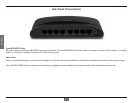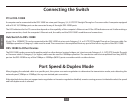
ENGLISH
8
Switching Technology
Switches provide full-line speed and dedicated bandwidth for all connections. This is in contrast to hubs, which use the traditional shared
networking topology, where the connected nodes contend for the same network bandwidth. When two switching nodes are communicating, they
are connected with a dedicated channel between them, so there is no contention for network bandwidth with other nodes. As a result, the switch
reduces considerably, the likelihood of trac congestion.
ForEthernetnetworks,aswitchisaneectivewayofeliminatingtheproblemofchaininghubsbeyondthe“two-repeaterlimit.”Aswitchcanbe
usedtosplitpartsofthenetworkintodierentcollisiondomains,makingitpossibletoexpandyourEthernetnetworkbeyondthe205-meter
network diameter limit for 100BASE-TX networks. Switches supporting both 10Mbps Ethernet and 100Mbps Fast Ethernet are also ideal for bridging
between existing 10Mbps networks and newer 100Mbps networks.
Switching LAN technology is a marked improvement over the previous generation of network hubs and bridges, which were characterized by
higher latencies. Routers have also been used to segment local area networks, but the cost of a router, the setup and maintenance required, make
routers relatively impractical. Today switches are an ideal solution to most kinds of local area network congestion problems.


















